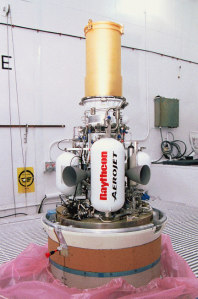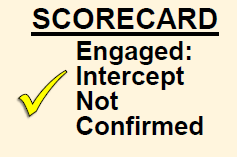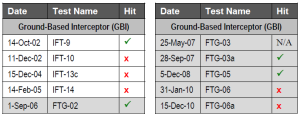At a March 15, 2013 press conference (transcript), U.S. Defense Secretary Chuck Hagel announced that U.S. would increase the number of Ground-Based Interceptors (GBIs) deployed as part of its Ground-Based Midcourse (GMD) national missile defense system from the current 30 to 44 by the end of 2017. At the press conference, Undersecretary of Defense for Policy James Miller said that their estimate was this deployment would cost just under $1 billion. Dr. Miller explained that this cost would include both the 14 additional interceptors and the cost of recommissioning Missile Field One at Fort Greely, Alaska. Does this cost seem plausible?

The Missile Defense Complex at Fort Greely, Alaska. The missile fields are at the left, with Missile Field 2 still under construction (MF = missile field, MEB = missile electrical building). Source: http://www.mda.mil/global/documents/pdf/GMD_DSC_Focused_Transition_brief.pdf
The U.S. currently has thirty GBIs deployed. Four are deployed at Vandenberg Air Force Base in California. The other 26 are deployed at Fort Greely Alaska in Missile Field 3 (20 silos) and the more recent Missile Field 2 (14 silos). The original Missile Field 1 (six silos) was shut down after the other missile fields became available. The new plan would purchase fourteen additional GBIs and deploy them at Fort Greely by filling in the eight empty silos in Missile Fields 2 & 3 and by reactivating the six silos of Missile Field 1.
How Much To Recommission Missile Field 1?
The cost of recommissioning Missile Field 1 is greater than one might expect. The six silos of of this missile field one were, like the GBI interceptors that were put in them, deployed very rapidly in order to meet President Bush’s goal of having an operational capability by the end of the 2004 fiscal year. According to one source, the construction of the field was completed with “27 minutes to spare.”[1]
As might be expected, problems ensued both with the GBIs and the silos. Some indication of the issues involved in recommissioning Missile Field 1 is given by the following written response (2010) by Secretary of Defense Robert M. Gates and Joint Chiefs Chairman Michael B. Mullen to a question from Alaska Senator Mark Begich:
“Once Missile Field 2 is fully operational, Missile Field 1 will be decommissioned since it was designed as a test bed only and is not hardened or sufficiently reliable for a long-term operational deployment. Specifically, Missile Field 1 lacks backup power and has significant infrastructure reliability issues. These reliability issues include extensive mold contamination in the Missile Field 1 utilidor, requiring personnel to suit up for a hazardous environment; inadequate valve connections in the chilled water system, resulting in leaks of glycol, and dust intrusion in Mechanical Electrical Building 1. The Missile Field 2 design includes shielding and addresses the reliability concerns of Missile Field 1.”[2]
Some additional information relevant to the above statement may be useful. First, at the time, as Gates and Mullen indicate, the plan was that Missile Field 1 would be “decommissioned.” Decommissioning basically involves returning the site to its pre-construction state and would have been both costly and irreversible. Under pressure from Congress, it was subsequently decided to place the missile field in storage instead, from which it could be returned to service in about two years. Second, while a “dust intrusion” might not seem like a serious problem, the dust was apparently getting into electrical switchgear, with potentially “catastrophic impacts.” Finally, a “utilidor” is a apparently a utility corridor.
The only cost estimate I have seen for re-commissioning the missile field is from 2010, when MDA Director Lt. General Patrick O’Reilly told Congress that the cost to reactivate the six silos of Missile Field 1 would be “on the order of $200 million”:
“So we would need to remediate that. We’d need to actually remove almost all of the active components of that missile field and replace them with newer ones. The time frame with that would be on the order of two years. The costs that we have looked at in the past when we looked at different options would be on the order of – and this has been done several years ago, sir, so the cost are somewhat approximate – would be on the order of $200 million.”[3]
How much for the Fourteen New GBI Interceptors?
If we assume $200 million for the missile field, this still leaves up to $800 million for the fourteen new GBI interceptors, or up to about $57 million per interceptor. This seems quite low.
As discussed in my post of July 24, up through 2011, cost estimates for a new GBI interceptor were consistently about $70 million each. As discussed in that post, the $70 million figure does not include the roughly $20 million per interceptor needed for repairs and retrofits.
Information that has subsequently become available indicates that current cost per interceptor may be significantly higher. The September 2012 Report by the National Academy of Sciences (p. 255) included the following cost breakdown for each GBI in a buy of five interceptors (data provided by the MDA, in FY 2010 dollars):
GBI Cost Element Unit Cost (million $)
EKV (kill vehicle) 29.8
Booster stack 19.8
Booster avionics modules 6.5
Integration, assembly, test and checkout 4.1
————————————————– —————————————-
Total cost 70.2
Note that the single largest cost element is the kill vehicle, which at $29.8 million is about 42% of the total cost of a GBI. The NAS Report does not indicate whether this cost was for the older CE-I version of the kill vehicle or the newer CE-II version (which will be the version deployed by 2017 on the fourteen new interceptors, assuming that it succeeds in its next test). However, the NAS Report noted that 2011 MDA budget documents indicated that the next batch of seven of CE-II kill vehicles was expected to cost about $39 million each, an increase of over $9 million per kill vehicle. In addition, the MDA told the NAS Panel that it was budgeting $85 million for its next batch of five GBI interceptors.
The Bottom Line
Based on the above discussion, the available data suggest a cost of about $200 + 14($70-$85) million ≈ $1.2 – $1.4 billion for the deployment of the fourteen additional interceptors, 20-40% great than the cost of just under $1 billion provided at the press conference.
[3] Response of Lt. General Patrick O’Reilly to a question from Representative Michael Turner. Hearing of the Strategic Forces Subcommittee, House Armed Services Committee, April 15, 2010.









